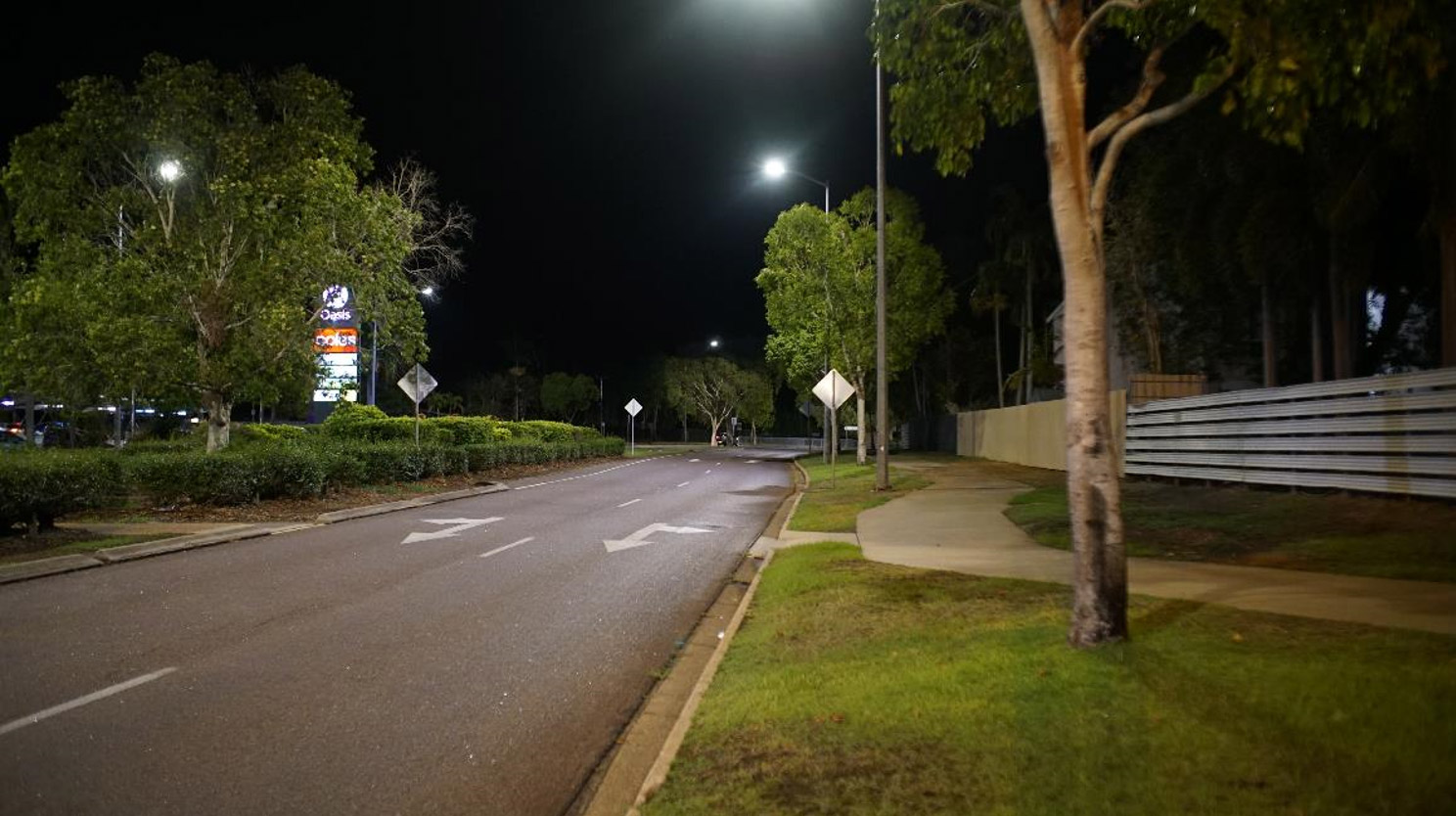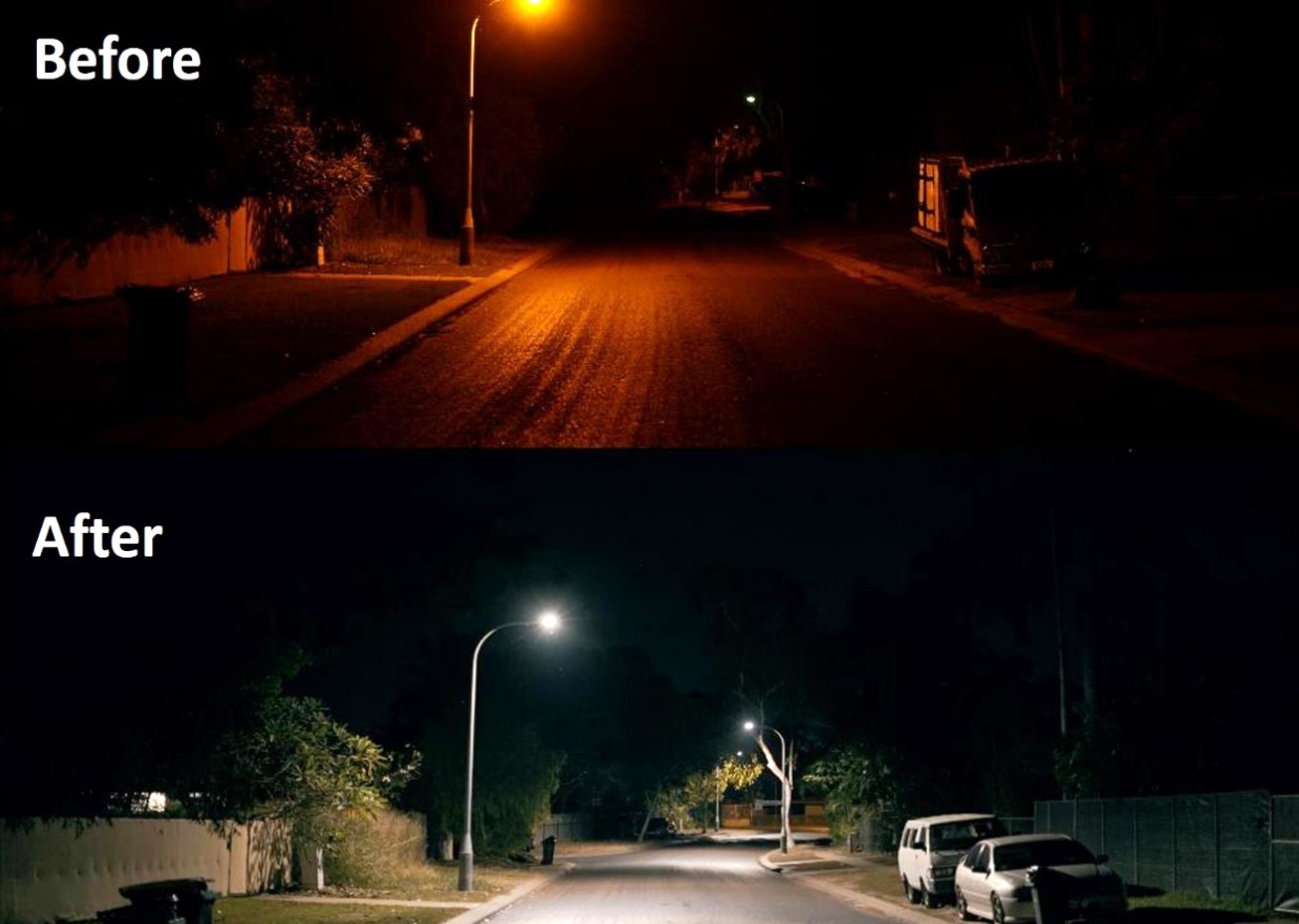The City of Palmerston, located just outside Darwin in the Northern Territory, is the first council in Australia to make the switch to a full deployment of LED street lighting with the latest smart technology across its 5,000 streetlights.
After a transfer of public lighting ownership from an electricity distributor to the council in 2018, the City of Palmerston decided to leverage the opportunity to gradually stage a changeover of all their street lighting to renewable, energy efficient LEDs and install smart city controls as part of their ‘Making the Switch’ project.

City of Palmerston Mayor, Athina Pascoe-Bell has been pleased with the outcomes so far.
“We’ve saved money for our ratepayers in the long term, cut our greenhouse gas emissions from street lighting in half and we have improved amenity and safety for the community. The new LEDs and smart control technologies will deliver significant savings in electricity costs and meet the environmental sustainability outcomes in our Community Plan. We are proud to be the first local government council in Australia to have accomplished this changeover,” said the Mayor.
A wide range of innovation was included in the ‘Making the Switch’ project and Council has cited a number of lessons learnt from it:
1. MATERIAL BENEFIT OF EXTENSIVE COMMUNITY CONSULTATION & TRIALS
With a range of new technologies under consideration, early LED trials were undertaken to build community support and elicit community feedback on the colour temperature of the lighting and the lighting levels. The community input was seen as being instrumental in shaping the project. Council’s decisions were also supported by extensive before and after lighting measurements at trial sites to help validate performance.

2. SEEKING EXPERT ADVICE & ENSURING KNOWLEDGE TRANSFER
City of Palmerston sought the input of highly qualified external consultants to help with all aspects of planning, procurement and deployment. This was also extended to external input to help transfer knowledge to council staff who are now managing the smart street lighting controls themselves and leading a program of further lighting upgrades.
3. INCLUSION OF SMART CONTROLS
Smart controls have been included with every luminaire and are allowing Council to manage its lighting in real time through a software platform. This platform is used to see whether lights are operational, help with fault identification, provide asset management and maintenance data, and allow Council to remotely dim or brighten lighting. The system also collects and aggregates energy consumption data with high accuracy and, in the future, this could potentially be used as metering data.
4. INCLUSION OF SMART SENSOR PORTS ON EVERY LIGHT
Looking forward, every luminaire in Palmerston has been fitted with an additional downward-facing Zhaga Book 18 interface. Zhaga interfaces can be compared to a USB for the outdoor environment. By including them, council is allowing for smart city sensors to be plugged in anytime in the future. Future sensors might count traffic, measure climate parameters or monitor for pollution. Palmerston’s deployment across its whole lighting network makes it one of the first cities in the world to fully provision its luminaires with this new technology.
5. RAISING LIGHTING CAPACITY & LIGHTING LEVELS
Australian residential roads are lit at some of the lowest lighting levels of any developed country. Community feedback in City of Palmerston’s early trial about the need for higher lighting levels was particularly strong so the decision was made to raise residential road lighting levels by a full lighting category when deploying the new LEDs.
Council has widely deployed higher capacity lighting and is using its smart controls to trim lighting levels on main roads to meet both compliance requirements and local community needs while giving itself the option of raising lighting levels at particular locations and times to suit local circumstances.
Importantly, Council has provided higher lighting levels across the community while still saving around 50% of the energy compared to its old lighting network. Installing higher capacity LEDs is becoming a common strategy overseas, however, the City of Palmerston is believed to be the first Australian council to widely deploy higher capacity lights across its portfolio.
6. NUANCED APPROACH TO COLOUR TEMPERATURE
With input from IPWEA, Council’s consultants, a review of developments overseas and after eliciting community feedback during trials, the City of Palmerston decided to primarily deploy 3000K LEDs (eg warm white) on residential roads to mitigate environmental risks and to deploy 4000K LEDs (eg neutral white) on main roads to maximise road safety on those roads where safety risks are the greatest.
Again, while some prominent LED projects in New Zealand, the UK and the US are being deployed with both 3000K and 4000K lighting, the City of Palmerston is thought to be the first Australian council to fully deploy LEDs with this strategy. Notably, two NSW utilities, Ausgrid and Essential Energy, have recently adopted a similar approach.
7. RE-INVESTING SAVINGS IN CONTINUOUS IMPROVEMENT
The City of Palmerston has undertaken regular reviews during the deployment including before and after site evaluations to ensure that its lighting project is delivering the expected outcomes. However, not even the best LEDs can fix every legacy lighting problem.
Council is utilising the savings from this project to address some of the historic problems with public lighting. Staff and consultants are using GIS information and a risk assessment tool to identify, prioritise and fill in gaps within the old lighting network.
City of Palmerston expects to save $2.59 million over the next 12 years from a combination of energy and maintenance savings and is reinvesting some of these funds towards continuous improvement across its lighting network.
In commenting on the completion of the project, David Jenkins, CEO of IPWEA Australasia said that “IPWEA has been heavily involved with public lighting issues for some years and regards Palmerston’s Making the Switch project as a landmark lighting project for Australia. Palmerston has shown significant leadership, pushing the boundaries across a range of new technologies and has delivered great outcomes in a careful and deliberate manner.”
Dr Dee Denteneer, Secretary General of the Zhaga Consortium has also congratulated the Palmerston Council on their efforts.
“Many congratulations to the City of Palmerston with Making the Switch. LEDs with smart controls will make the city brighter, safer, and healthier at lower costs. Taking a Zhaga-based approach ensures that the benefits are lasting and future-proof. A smart switch indeed,” he said.
Suppliers to the City of Palmerston’s Making the Switch project include SLSC Program Partners Signify, OrangeTek, Light Source Solutions and Telensa, installation contractor, ESPEC PH and independent lighting consultants, Next Energy. For more information on City of Palmerston’s Making the Switch program, read more.














